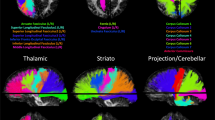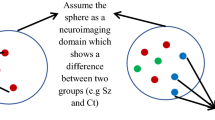Abstract
White matter hyperintensities (WMH) and atrophy are common findings in neurodegenerative diseases as well as healthy aging. However, it is not clear whether their co-occurrence is due to shared risk factors. Previous work has analyzed univariate associations between individual brain regions but not joint patterns over multiple regions. We propose a new method that jointly analyzes all the regions to discover spatial association patterns between WMH and atrophy. Univariate analyses typically correct for shared risk factors at the level of individual WMH and atrophy variables. Our method incorporates a novel correction strategy at the level of the entire pattern over multiple regions. Furthermore, we enforce sparsity to yield interpretable results. Results in a cohort of 703 participants from the Rhineland Study reveal two consistent spatial association patterns. Correction of individual variables did not yield qualitatively different patterns. Our proposed multi-variate correction strategy yielded different patterns thus, suggesting that it might be more appropriate for multi-variate analysis.
Access this chapter
Tax calculation will be finalised at checkout
Purchases are for personal use only
Similar content being viewed by others
References
Dale, A.M., Fischl, B., Sereno, M.I.: Cortical surface-based analysis. I. Segmentation and surface reconstruction. Neuroimage 9(2), 179–194 (1999)
Du, A.T., et al.: Age effects on atrophy rates of entorhinal cortex and hippocampus. Neurobiol. Aging 27, 733–740 (2006)
Fischl, B., et al.: Whole brain segmentation: automated labeling of neuroanatomical structures in the human brain. Neuron 33(3), 341–355 (2002)
Sudre, C.H., et al.: Bullseye’s representation of cerebral white matter hyperintensities. J. Neuroradiol. 45(2), 114–122 (2017)
Witten, D.M., Tibshirani, R., Hastie, T.: A penalized matrix decomposition, with applications to sparse principal components and canonical correlation analysis. Biostatistics 10(3), 515–534 (2009)
Korf, E.S.C., White, L.R., Scheltens, P., Launer, L.J.: Midlife blood pressure and the risk of hippocampal atrophy. Hypertension 44, 29–34 (2004)
Griffanti, L., et al.: BIANCA (Brain Intensity AbNormality Classification Algorithm): a new tool for automated segmentation of white matter hyperintensities. Neuroimage 141, 191–205 (2016)
Breteler, M.M.B., Wolf, H.: The Rhineland study: a novel platform for epidemiologic research into alzheimer disease and related disorders. Alzheimer’s & Dement. 10(4), 520 (2014)
Breteler, M.M.B., et al.: Cognitive correlates of ventricular enlargement and cerebral white matter lesions on magnetic resonance imaging. Rotterdam Study. Stroke 25(6), 1109–1115 (1994)
Diamond, S., Boyd, S.: CVXPY: a python-embedded modeling language for convex optimization. J. Mach. Learn. Res. 17(83), 1–5 (2016)
Qi, S.: Multimodal fusion with reference: searching for joint neuromarkers of working memory deficits in Schizophrenia. IEEE Trans. Med. Imaging 37(1), 93–105 (2018)
den Heijer, T., et al.: Association between blood pressure, white matter lesions, and atrophy of the medial temporal lobe. Neurology 64, 263–267 (2005)
Author information
Authors and Affiliations
Corresponding author
Editor information
Editors and Affiliations
Rights and permissions
Copyright information
© 2018 Springer Nature Switzerland AG
About this paper
Cite this paper
Sanroma, G. et al. (2018). SCCA-Ref: Novel Sparse Canonical Correlation Analysis with Reference to Discover Independent Spatial Associations Between White Matter Hyperintensities and Atrophy. In: Shi, Y., Suk, HI., Liu, M. (eds) Machine Learning in Medical Imaging. MLMI 2018. Lecture Notes in Computer Science(), vol 11046. Springer, Cham. https://doi.org/10.1007/978-3-030-00919-9_10
Download citation
DOI: https://doi.org/10.1007/978-3-030-00919-9_10
Published:
Publisher Name: Springer, Cham
Print ISBN: 978-3-030-00918-2
Online ISBN: 978-3-030-00919-9
eBook Packages: Computer ScienceComputer Science (R0)




